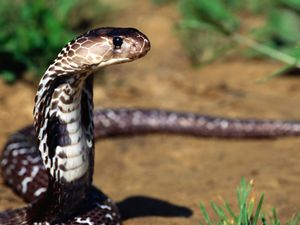كوبرا
| كوبرا Naja | |
|---|---|
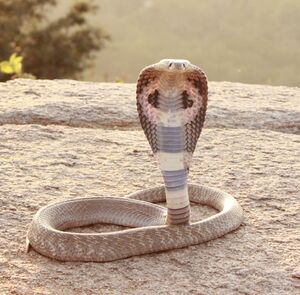
| |
| Indian cobra (Naja naja), species typica of the genus | |
| التصنيف العلمي | |
| مملكة: | |
| Phylum: | |
| Subphylum: | |
| Class: | |
| Order: | كثيرات الحراشف Squamata
|
| Suborder: | |
| Family: | حرشفيات Elapidae
|
| Genus: | Naja |
ثعبان الكوبرا من الحيات السامة وتعتبر أكثر فصائل الحيات إنتشارا في العالم ، ويوجد منها 21 نوع.
الكوبرا أفعى من مجموعة الثعابين السامة. وأفعى الكوبرا نشيطة جدًا، وإذا استثيرت حركت ضلوع رقبتها فتبدو مسطحة. وهذه الحركة تجعلها تبدو وكأن لرأسها غطاء. وفي معظم الثعابين تبدو ضلوع الرقبة أقصر من ضلوع الظهر البعيدة، لكن الكوبرا تبدو ضلوع رقبتها أكثر طولاً. وهذه الضلوع مستقيمة الشكل تقريباً، وليست منحنية كضلوع الجسم. وللكوبرا طريقتان في استخدام سمها القاتل. البعض منها ينهش ضحاياه بأنيابه السامة الموجودة في مقدمة الفك العلوي. وبعضها الآخر يقوم بنفث السم في عين ضحيته. في هذه الأنواع تتخذ الأنياب شكلاً يتيح لها نفث السم للأمام عندما تعود الكوبرا برأسها للوراء. ويتم نفث السم بهذه الطريقة الفعالة عند نوعين من الكوبرا الإفريقية، ونوع آخر في شرق الهند. ولايصيب السم المنفوث الإنسان بالأذى إلا في حالة دخوله العينين. إذ يسبب تهيجًا شديدًا، وقد يؤدي إلى فقد الإبصار، مالم تُغسل العينان فورا. وقد يُسبِّب النهش موت الإنسان خلال ساعات قليلة.
يبلغ طول الكوبرا الهندية المكتملة النمو نحو مترين، وقطرها نحو 15سم. ويتدرج لونها من المائل للاصفرار إلى البني القاتم. وفي مؤخرة غطاء رأسها علامة تشبه النظارة، لذلك تسمى أحياناً بالكوبرا ذات النظارة.
تأكل معظم أفاعي الكوبرا أنواعًا كثيرة من الحيوانات مثل الضفادع والأسماك والطيور وأنواعًا عدة من الثدييات الصغيرة. يعد حيوان النمس الصغير عدوًا خطيرًا للكوبرا. فهو سريع جداً، يهاجم الأفعى ويقتلها عادة.
يلجأ السحرة والحواة في الهند عادة إلى استخدام الكوبرا لغطاء رأسها الغريب ولعادتها في التقهقر إلى الخلف منتصبة. ويدَّعي الحواة أنهم يسحرون الثعابين بالموسيقى، إلا أن الثعابين لاتسمع سوى قدر ضئيل من الأصوات، ولاتستطيع سماع الموسيقى. ويظن بعضهم أن الكوبرا مسحورة عندما يرونها تتخذ وضع التأهب والحذر. وهو ما قد تفعله دون موسيقى.
وصف الحيوان
ثعبان سام كبير الحجم قد يصل طولة إلى اكثر من مترين تقريبا ذو الوان مختلفة فقد يكون بني اللون مخضرا من ناحية ظهرة أما البطن فلونه يميل إلى الاصفرار الراس في ضختمة العنق والاعين كبيرة نسبيا وإنسان العين حلقي الشكل ، الجسم اسطواني ومغطى بحراشيف ملساء ذات صفوف مائلة الفك العلوي يحتوي على زوج من الانياب الكبيرة الحادة التي تليها بعض الاسنان الصغيره اما الفك السفلي فيحتوي على أنياب طويله ن وأهم مايميز هذا الثعبان مقدرته على النفخ رقبته مكونا مايسمى بالقلنسوه كذالك يرفع ثلثه الامامي من الجسم إلى أعلى وهو بهذا السلوك يعطي إنطباعا مخيف للإنسان
الموطن والمعيشه
توجد الكوبرا في أماكن مختلفة، وقد تتسلل إلى البيوت، وليست الكوبرا بالخطورة الشائعة عنها، ويرجع ذلك إلى طريقتها في الهجوم. فالكوبرا ـ على عكس الأفعى الجرسية وغيرها من الأفاعي السامة ـ تستعد للمعركة برفع مقدمة جسدها دون أن تثنيه مثل حرف S. وبهذا يستطيع خصمها أن يقدّر جيدًا مدى الضربة الأمامية. ولايجد الإنسان صعوبة في قتل كوبرا تتراجع أمامه بالتلويح بعصا مستقيمة. ولاتستطيع أنياب الكوبرا نفث السم بنفس دقة أنياب الأفاعي السامة. وأنياب الكوبرا قصيرة، ولاتستطيع أن تنثني إلى الخلف، إلا أن الكوبرا تمضغ ما تقتنصه غالباً. وهذه العادة تساعدها على حقن السم في ضحيتها.
يكثر بالقرب من الاراضي الزراعيه كما أنه قد يرى أحيانا عند التجمعات المائيه بين المزارع حيث أنه يحسن السباحه ، يتغذى على الفئران والطيور الصغيره والسحالي يمتاز هذا الثعبان بأنه حاد الطباع وسريع الحركه وقد يهاجم الانسان إذا ماأثير ونستطيع القول بأنه يعتبر من أخطر الثعابين على الاطلاق والكوبرا ذو معيشه نهاريه
التوزيع الجغرافي
تعيش أفاعي الكوبرا في إفريقيا، وجنوب آسيا، وجزر الهند الشرقية بما فيها جزر الفلبين. تُعتبر أفعى الكوبرا الملك التي تعيش في جنوب شرقي آسيا، أكبر أنواع الكوبرا، كما أنها أطول الثعابين السامة المعروفة في العالم، إذ يبلغ طولها 5,5م ولها غطاء رأس ضيق. ومعظم أفاعي الكوبرا الملك تجفل من الناس، ولاتهاجمهم إلا عند مباغتتها، وهي تحرس بيضها. وجل فرائس أفاعي الكوبرا الملك من الثعابين الأخرى.
واسع الانتشار حيث يمتد تواجده من مصر إلى المغرب في شمال أفريقيا وجنوبا في الصومال وكذالك يمتد إنتشاره في الجنوب من فلسطين وفي الجزيرة العربيه
درجة السمية
يعد هذا الثعبان من أخطر وأشرس الثعابين السامه كما أنه قد يشكل خطرا على الفلاحين حيث يكثر في البيئات الزراعيه ، وسمه قاتل للإنسان ويهاجم الجهاز العصبي كما يوجد هناك نوع من الكوبرا يسمى الصل تصل الكميه القاتله لإنسان وزنه 70 كجم حوالي 15-20ملجم واكتشف علماء الحيوان الالمان في تجارب على الثعابين البصاقة التي تعد من أكثر الانواع سمية في العالم أن ثعبان (الكوبرا) يطلق بصورة متعمدة تيار سمه نحو العيون.
ويقول الاشخاص الذي نجوا أثناء مواجهتهم هذه الثعابين الافريقية التي ي صل طولها إلى مترين إن السم الذي يطلقه الثعبان على العين يسبب آلاما شديدة وفي بعض الحالات يؤدي إلى العمى. وكان يعتقد في السابق أن ثعبان الكوبرا ليس له هدف محدد وإنما يوجه سمه نحو الصدر أو الرأس.
وكشفت دراسة لجامعة بون أن الثعبان البصاق يحرك رأسه من جانب لاخر لتحسين دقة تصويبه تماما مثل لاعب التنس الذي يتأرجح يمينا ويسارا وهو ينتظر ضربة الارسال.
وتستغرق عملية هز الرأس وبخ السم واحد على 20 من الثانية وهي سرعة كبيرة للغاية لا تسمح بمشاهدة السم وهو يخرج من بين أنياب الثعبان. ويحتوي سم الثعبان على مواد سامة تضر بالاعصاب بالاضافة إلى مكونات تؤدي أيضا إلى احتراق أنسجة العين.
هذا الثعبان يقتل فريسته بعضته السامة ويستخدم البصق فحسب للدفاع عن النفس وهو يعيش على افتراس الحيوانات الصغيرة وغيرها من الثعابين الاخرى ولكنه لا يفترس الاشخاص.
التبويب
- Anchieta's Cobra, Naja anchietae (Bocage, 1879)
- Snouted Cobra, Naja annulifera (Peters, 1854)
- الكوبرا الصينية, Naja atra (Cantor, 1842)
- الكوبرا المصرية, Naja haje (Linnaeus, 1758)
- Monocles Cobra, Naja kaouthia (Lesson, 1831)
- Mali Cobra, Naja katiensis (Angel, 1922)
- كوبرا ماندلاي البصاقة, Naja mandalayensis (Slowinski & Wüster, 2000)
- كوبرا مخططة, Naja melanoleuca (Hallowell, 1857)
- كوبرا موزمبيق البصاقة, Naja mossambica (Peters, 1854)
- كوبرا هندية, Naja naja (Linnaeus, 1758)
- كوبرا سوداء الرقبة بصاقة, Naja nigricollis (Reinhardt, 1843)
- Cape Cobra, Naja nivea (Linnaeus, 1758)
- كوبرا نوبية بصاقة, Naja nubiae (Wüster & Broadley, 2003)
- كوبرا وسط آسيا, Naja oxiana (Eichwald, 1831)
- كوبرا حمراء بصاقة, Naja pallida (Boulenger, 1896)
- كوبرا فلبينية, Naja philippinensis (Boulenger, 1896)
- كوبرا أندمان, Naja sagittifera (Wall, 1913)
- Peters' Cobra, Naja samarensis (Peters, 1861)
- كوبرا الهند الصينية البصاقة, Naja siamensis (Laurenti, 1768)
- كوبرا إندونيسية, Naja sputatrix (Boie, 1827)
- كوبرا ذهبية بصاقة, Naja sumatrana (Müller, 1890)
| Naja |
| |||||||||||||||||||||||||||||||||||||||||||||||||||||||||||||||||||||||||||||||||||||||||||||||||||||||||||||||||||||||||||||||||||||||||||||||||||||||||||||||||||||||||||||||||
The genus contains several species complexes of closely related and often similar-looking species, some of them only recently described or defined. Several recent taxonomic studies have revealed species not included in the current listing in ITIS:[1][2]
- Naja anchietae (Bocage, 1879), Anchieta's cobra, is regarded as a subspecies of N. haje by Mertens (1937) and of N. annulifera by Broadley (1995). It is regarded as a full species by Broadley and Wüster (2004).[3][4]
- Naja arabica Scortecci, 1932, the Arabian cobra, has long been considered a subspecies of N. haje, but was recently raised to the status of species.[5]
- Naja ashei Broadley and Wüster, 2007, Ashe's spitting cobra, is a newly described species found in Africa and also a highly aggressive snake; it can spit a large amount of venom.[6][7]
- Naja nigricincta Bogert, 1940, was long regarded as a subspecies of N. nigricollis, but was recently found to be a full species (with N. n. woodi as a subspecies).[8][9]
- Naja senegalensis Trape et al., 2009, is a new species encompassing what were previously considered to be the West African savanna populations of N. haje.[5]
- Naja peroescobari Ceríaco et al. 2017, is a new species encompassing what was previously considered the São Tomé population of N. melanoleuca.[10]
- Naja guineensis Broadley et al., 2018, is a new species encompassing what were previously considered to be the West African forest populations of N. melanoleuca.[11]
- Naja savannula Broadley et al., 2018, is a new species encompassing what were previously considered to be the West African savanna populations of N. melanoleuca.[11]
- Naja subfulva Laurent, 1955, previously regarded as a subspecies of N. melanoleuca, was recently recognized as a full species.[11]
Two recent molecular phylogenetic studies have also supported the incorporation of the species previously assigned to the genera Boulengerina and Paranaja into Naja, as both are closely related to the forest cobra (Naja melanoleuca).[8][12] In the most comprehensive phylogenetic study to date, 5 putative new species were initially identified, of which 3 have since been named.[13]
The controversial amateur herpetologist Raymond Hoser proposed the genus Spracklandus for the African spitting cobras.[14] Wallach et al. suggested that this name was not published according to the Code and suggested instead the recognition of four subgenera within Naja: Naja for the Asiatic cobras, Boulengerina for the African forest, water and burrowing cobras, Uraeus for the Egyptian and Cape cobra group and Afronaja for the African spitting cobras.[15] International Commission on Zoological Nomenclature issued an opinion that it “finds no basis under the provisions of the Code for regarding the name Spracklandus as unavailable”.[16]
Asiatic cobras are believed to further be split into two groups of southeastern Asian cobras (N. siamensis, N. sumatrana, N. philippinensis, N. samarensis, N. sputatrix, and N. mandalayensis) and western and northern Asian cobras (N. oxiana, N. kaouthia, N. sagittifera, and N. atra) with Naja naja serving as a basal lineage to all species.[17]
الأنواع
| Image[1] | Species[1] | Authority[1] | Subsp.*[1] | Common name | Geographic range |
|---|---|---|---|---|---|
| N. anchietae | Bocage, 1879 | 0 | Anchieta's cobra (Angolan Cobra) | Angola, Botswana, Namibia, Zambia, eastern Zimbabwe | |
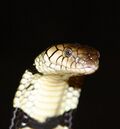
|
N. annulata | (Buchholz and Peters, 1876) | 1 | Banded water cobra | Cameroon, the Central African Republic, the Democratic Republic of the Congo (Zaire), the Republic of Congo, Equatorial Guinea, Gabon, Rwanda, and the province of Cabinda in Angola |

|
N. annulifera | Peters, 1854 | 0 | Snouted cobra | Botswana, Malawi, Mozambique, South Africa, Swaziland, Zambia, Zimbabwe |
| †N. antiqua | Rage, 1976 | 0 | Miocene-aged strata of Morocco | ||
| N. arabica | Scortecci, 1932 | 0 | Arabian cobra | Oman, Saudi Arabia, Yemen | |
| N. ashei | Wüster and Broadley, 2007 | 0 | Ashe's spitting cobra (giant spitting cobra) | southern Ethiopia, Kenya, Somalia, eastern Uganda | |

|
N. atra | Cantor, 1842 | 0 | Chinese cobra | southern China, northern Laos, Taiwan, northern Vietnam |
| N. christyi | (Boulenger, 1904) | 0 | Congo water cobra | the Democratic Republic of the Congo (Zaire), the Republic of Congo, and the province of Cabinda in Angola | |
| N. fuxi |
Shi, Vogel, Chen, & Ding, 2022 |
0 | Brown banded cobra | China, Myanmar, Laos, Thailand, Vietnam | |
| N. guineensis | Broadley, Trape, Chirio, Ineich &Wüster, 2018 | 0 | Black forest cobra | Ghana, Guinea, Guinea-Bissau, the Ivory Coast, Liberia, Sierra Leone, Togo | |
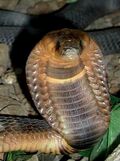
|
N. haje | Linnaeus, 1758 | 0 | Egyptian cobra | Tanzania, Kenya, Somalia, Ethiopia, Uganda, South Sudan, Sudan, Cameroon, Nigeria, Niger, Burkina Faso, Mali, Senegal, Mauritania, Morocco, Algeria, Tunisia, Libya, and Egypt |
| †N. iberica | Szyndlar, 1985 | Miocene-aged strata of Spain | |||
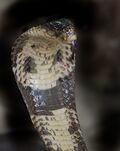
|
N. kaouthia | Lesson, 1831 | 0 | Monocled cobra | Bangladesh, Bhutan, Burma, Cambodia, southern China, eastern India, Laos, northwestern Malaysia, Nepal, Thailand, southeastern Tibet, Vietnam |

|
N. katiensis | Angel, 1922 | 0 | Mali cobra (Katian spitting cobra) | Benin, Burkina Faso, Cameroon, Ghana, Guinea, the Ivory Coast, Mali, Gambia, Mauritania, Niger, Nigeria, Senegal, Togo |

|
N. mandalayensis | Slowinski & Wüster, 2000 | 0 | Mandalay spitting cobra (Burmese spitting cobra) | Myanmar (Burma) |
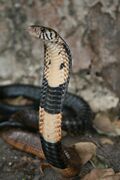
|
N. melanoleuca | Hallowell, 1857 | 0 | Central African forest cobra | Angola, Benin, Cameroon, the Central African Republic, the Republic of Congo, the Democratic Republic of the Congo (Zaire), Equatorial Guinea, Gabon, Nigeria |

|
N. mossambica | Peters, 1854 | 0 | Mozambique spitting cobra | extreme southeastern Angola, Botswana, Malawi, Mozambique, Somalia, northeastern Namibia, South Africa, Swaziland, Tanzania (including Pemba Island), Zambia, Zimbabwe |
| N. multifasciata | Werner, 1902 | 0 | Many-banded cobra | Cameroon, Congo, the Democratic Republic of the Congo (Zaire), Gabon | |

|
N. naja | (Linnaeus, 1758) | 0 | Indian cobra (spectacled cobra) | Bangladesh, Bhutan, India, Nepal, Pakistan, Sri Lanka |
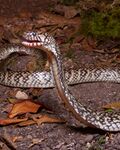
|
N. nana | Collet & Trape, 2020 | 0 | Dwarf water cobra | Democratic Republic of Congo |

|
N. nigricincta | Bogert, 1940 | 1 | Zebra spitting cobra | Angola, Namibia, South Africa |

|
N. nigricollis | Reinhardt, 1843 | 0 | Black-necked spitting cobra | Angola, Benin, Burkina Faso, Burundi, Cameroon, the Central African Republic, Chad, the Democratic Republic of the Congo (Zaire) (except in the central region), Congo, Ethiopia, Gabon, Gambia, Ghana, Guinea-Bissau, Guinea, the Ivory Coast, Kenya, Liberia, Mali, Mauritania, Namibia, Niger, Nigeria, Rwanda, Senegal, Sierra Leone, Sudan, Tanzania, Somalia, Togo, Uganda, Zambia |
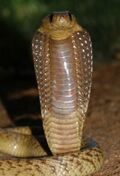
|
N. nivea | (Linnaeus, 1758) | 0 | Cape cobra (yellow cobra) | Botswana, Lesotho, Namibia, South Africa |

|
N. nubiae | Wüster & Broadley, 2003 | 0 | Nubian spitting cobra | Chad, Egypt, Eritrea, Niger, Sudan |

|
N. oxiana | (Eichwald, 1831) | 0 | Caspian cobra | Afghanistan, northwestern India, Iran, Kyrgyzstan, Pakistan, Tajikistan, Turkmenistan, Uzbekistan |

|
N. pallida | Boulenger, 1896 | 0 | Red spitting cobra | Djibouti, Ethiopia, Kenya, Somalia, Tanzania |
| N. peroescobari | Ceríaco, Marques, Schmitz & Bauer, 2017 | 0 | São Tomé forest cobra, cobra preta | São Tomé and Príncipe (São Tomé) | |
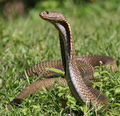
|
N. philippinensis | Taylor, 1922 | 0 | Philippine cobra | the Philippines (Luzon, Mindoro) |
| †N. romani | (Hofstetter, 1939) | 0 | † | Miocene-aged strata of France, Germany, Austria, Russia, Hungary, Greece and Ukraine.[18] | |

|
N. sagittifera | Wall, 1913 | 0 | Andaman cobra | India (the Andaman Islands) |

|
N. samarensis | Peters, 1861 | 0 | Samar cobra | the Philippines (Mindanao, Bohol, Leyte, Samar, Camiguin) |
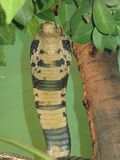
|
N. savannula | Broadley, Trape, Chirio & Wüster, 2018 | 0 | West African banded cobra | Benin, Burkina Faso, Cameroon, Chad, Gambia, Ghana, Guinea, the Ivory Coast, Mali, Niger, Nigeria, Senegal, Togo |
| N. senegalensis | Trape, Chirio & Wüster, 2009 | 0 | Senegalese cobra | Benin, Burkina Faso, Ghana, Guinea, Mali, Niger, Nigeria, Senegal | |
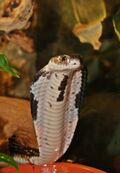
|
N. siamensis | Laurenti, 1768 | 0 | Indochinese spitting cobra | Cambodia, Laos, Thailand, Vietnam |
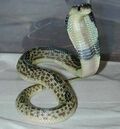
|
N. sputatrix | F. Boie, 1827 | 0 | Javan spitting cobra | Indonesia (Java, the Lesser Sunda Islands, East Timor) |

|
N. subfulva | Laurent, 1955 | 0 | Brown forest cobra | Angola, Burundi, Cameroon, the Central African Republic, Chad, the Republic of Congo, the Democratic Republic of the Congo (Zaire), Ethiopia, Kenya, Malawi, Mozambique, Nigeria, Rwanda, Somalia, South Africa, South Sudan, Tanzania, Uganda, Zambia, Zimbabwe |
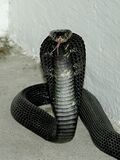
|
N. sumatrana | Müller, 1887 | 0 | Equatorial spitting cobra | Brunei, Indonesia (Sumatra, Borneo, Bangka, Belitung), Malaysia, the Philippines (Palawan), southern Thailand, Singapore |
- Not including the nominate subspecies
† Extinct
T Type species[19]
الوصلات الخارجية
- EMBL Reptile Database - Family Elapidae
- نوع Naja في قاعدة بيانات EMBL للزواحف
- Naja (TSN 700233). Integrated Taxonomic Information System. Accessed on 5 May 2006.
- ^ أ ب ت ث ج خطأ استشهاد: وسم
<ref>غير صحيح؛ لا نص تم توفيره للمراجع المسماةITIS - ^ Kazemi, Elmira; Nazarizadeh, Masoud; Fatemizadeh, Faezeh; Khani, Ali; Kaboli, Mohammad (2021). "The phylogeny, phylogeography, and diversification history of the westernmost Asian cobra (Serpentes: Elapidae: Naja oxiana) in the Trans-Caspian region". Ecology and Evolution (in الإنجليزية). 11 (5): 2024–2039. doi:10.1002/ece3.7144. ISSN 2045-7758. PMC 7920780. PMID 33717439.
- ^ Broadley, D.G.; Wüster, W. (2004). "A review of the southern African 'non-spitting' cobras (Serpentes: Elapidae: Naja)". African Journal of Herpetology. 53 (2): 101–122. doi:10.1080/21564574.2004.9635504. S2CID 84853318.
- ^ قالب:NRDB species
- ^ أ ب Trape, J.-F.; Chirio, L.; Broadley, D.G.; Wüster, W. (2009). "Phylogeography and systematic revision of the Egyptian cobra (Serpentes: Elapidae: Naja haje) species complex, with the description of a new species from West Africa". Zootaxa. 2236: 1–25. doi:10.11646/zootaxa.2236.1.1.
- ^ Wüster, W.; Broadley, D.G. (2007). "Get an eyeful of this: a new species of giant spitting cobra from eastern and north-eastern Africa (Squamata: Serpentes: Elapidae: Naja)". Zootaxa. 1532: 51–68. doi:10.11646/zootaxa.1532.1.4.
- ^ قالب:NRDB species
- ^ أ ب Wüster, W.; Crookes, S.; Ineich, I.; Mane, Y.; Pook, C.E.; Trape, J.-F.; Broadley, D.G. (2007). "The phylogeny of cobras inferred from mitochondrial DNA sequences: evolution of venom spitting and the phylogeography of the African spitting cobras (Serpentes: Elapidae: Naja nigricollis complex)". Molecular Phylogenetics and Evolution. 45 (2): 437–453. doi:10.1016/j.ympev.2007.07.021. PMID 17870616.
- ^ قالب:NRDB species
- ^ Ceríaco, L; et al. (2017). "The "Cobra-preta" of São Tomé Island, Gulf of Guinea, is a new species of Naja Laurenti, 1768 (Squamata: Elapidae)". Zootaxa. 4324 (1): 121–141. doi:10.11646/zootaxa.4324.1.7.
- ^ أ ب ت Wüster, W; et al. (2018). "Integration of nuclear and mitochondrial gene sequences and morphology reveals unexpected diversity in the forest cobra (Naja melanoleuca) species complex in Central and West Africa (Serpentes: Elapidae)". Zootaxa. 4455 (1): 68–98. doi:10.11646/zootaxa.4455.1.3. PMID 30314221.
- ^ Nagy, Z.T., Vidal, N., Vences, M., Branch, W.R., Pauwels, O.S.G., Wink, M., Joger, U., 2005. Molecular systematics of African Colubroidea (Squamata: Serpentes). In: Huber, B.A., Sinclair, B.J., Lampe, K.-H. (Eds.), African Biodiversity: Molecules, Organisms, Ecosystems. Museum Koenig, Bonn, pp. 221–228.
- ^ خطأ استشهاد: وسم
<ref>غير صحيح؛ لا نص تم توفيره للمراجع المسماة:0 - ^ Hoser, R., 2009. Naja, Boulengerina and Paranaja. Australasian Journal of Herpetology, 7, pp.1-15.
- ^ خطأ استشهاد: وسم
<ref>غير صحيح؛ لا نص تم توفيره للمراجع المسماةwallach - ^ "Opinion 2468 (Case 3601) – Spracklandus Hoser, 2009 (Reptilia, Serpentes, Elapidae) and Australasian Journal of Herpetology issues 1–24: confirmation of availability declined; Appendix A (Code of Ethics): not adopted as a formal criterion for ruling on Cases". The Bulletin of Zoological Nomenclature. 78 (1): 42–45. 2021. doi:10.21805/bzn.v78.a012. ISSN 0007-5167. S2CID 233448875.
- ^ Kazemi, Elmira; Nazarizadeh, Masoud; Fatemizadeh, Faezeh; Khani, Ali; Kaboli, Mohammad (2020-08-18). "Phylogeny, phylogeography and diversification history of the westernmost Asian cobra (Naja oxiana) in the Trans-Caspian region". dx.doi.org. doi:10.22541/au.159774318.89992224. S2CID 225411032. Retrieved 2021-04-17.
- ^ Syromyatnikova, E.; Tesakov, A.; Titov, V. (2021). "Naja romani (Hoffstetter, 1939)(Serpentes: Elapidae) from the late Miocene of the Northern Caucasus: the last East European large cobra". Geodiversitas. 43 (19): 683–689. doi:10.5252/geodiversitas2021v43a19. S2CID 238231298.
- ^ خطأ استشهاد: وسم
<ref>غير صحيح؛ لا نص تم توفيره للمراجع المسماةZ&A93
